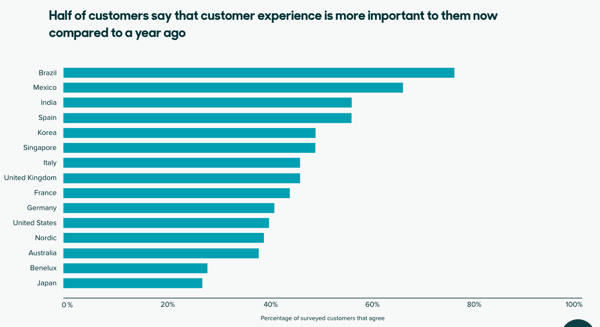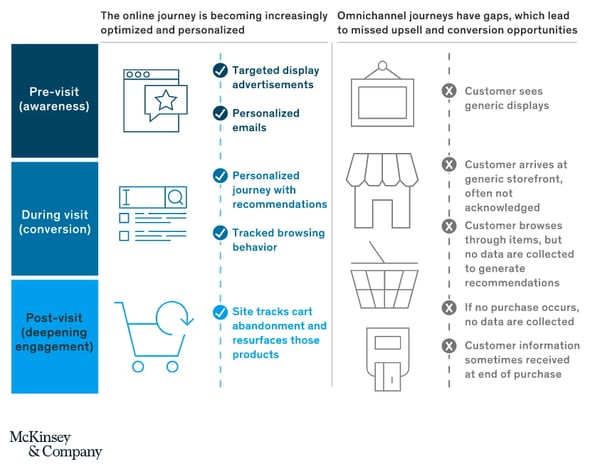A 2021 Mckinsey & Company report found that 78% of consumers are more likely to make repeat purchases from brands that personalize. Nearly 80% are also more likely to refer their family and friends to these companies.
As we know, personalization is the name of the game in customer experience nowadays. In this post, we’ll dive into key personalization trends you should know in 2022.
Demand for personalization is increasing.
According to Twilio’s 2022 State of Personalization Report, 62% of consumers say a brand will lose their loyalty if they deliver an un-personalized experience, up nearly 20% from 2021.
Another report by Zendesk suggests that customer experience is more important to consumers now than it was before.

This uptick in a need for personalization didn’t just start recently, it grew in part due to the pandemic in 2020. This was a time of uncertainty that forced most consumers indoors and online for an extended period of time.
The Mckinsey & Company report reported that 75% of consumers tried a new shopping behavior during the pandemic. Consumers are seeking more valuable experiences from the brands they engage with.
In fact, the same study revealed that over 70% of consumers now expect personalization and are frustrated when they don’t find it – making personalization a must-have for today’s brands.
Online personalization is prioritized.
According to a 2021 Zendesk report, 65% of customers want to buy from companies that offer quick and easy online transactions.
The report also found that online companies are outperforming, with ecommerce brands leading in consumer engagement.
Here’s why: Online offers many more opportunities for personalization than in-person. You can target users to see your ad then follow them through their journey, as they discover your products and consider purchases.

In-person, customers typically see generic displays followed by generic store experiences. Meanwhile, brands are unable to collect any data regarding items customers viewed and considered unless there was a purchase.
With these obstacles, many brands find it easier to personalize their marketing efforts online.
Omnichannel is the main way forward.
Only 35% of companies feel they are successfully achieving omnichannel personalization, up 13% from 2021 – according to Twilio’s 2022 State of Personalization report.
With consumers now actively engaging across multiple channels, effective personalization depends on an omnichannel approach that meets consumers where they are, not where brands expect them to be.
When it comes to personalized marketing, this is pretty badass.
Kudos @JetBlue! pic.twitter.com/sly4OEuKBl
— Cole Cook (@cwcook22)
June 24, 2022
One 2021 report by Vonage revealed that 26% of consumers are very likely to stop buying from a business if they can’t switch between communication channels.
However, McKinsey & Company notes some roadblocks to a seamless omnichannel strategy. Here are the two main ones:
- Traditionally, digital and customer-facing channels work independently so changing requires interlinking software and hardware.
- It involves changing the customer journey flow, which involves retraining staff and updating the process.
While these aren’t minor challenges, they can be addressed with the right team and resources.
Companies will prioritize first-party data as privacy concerns mount.
With the end of third-party cookies and the recent data privacy laws, brands have had to pivot their approach to collecting data. This shift has caused a domino effect, impacting personalization strategies.
According to Twilio’s 2022 State of Personalization Report, 37% of brands exclusively use first-party data to personalize customer experiences, a six percentage point increase compared to 2021.
Why? The first reason is higher quality data, according to 54% of respondents. The report shows that accurate data is a particular challenge for brands, keeping them from fully implementing personalization strategies.
Other reasons include better privacy and easier management.
Collecting first-party data enables companies to make better decisions more quickly and integrate their systems more easily for a seamless experience – for both marketers and consumers.
Key Tips About Personalization
- Customization is not personalization. Customization is explicit, while personalization is implicit.
- You can achieve intent-driven personalization by understanding what people engage with on your site.
- Never forget that no matter how much technology changes, the key to great marketing is having an in-depth understanding of users.
- The future of marketing is in making websites, products, or experiences personal in a deeply meaningful way.
- The personalization of search results offers an opportunity to increase your visibility for really relevant searches.
- The potential to engage customers contextually based on a need and serve that in real-time will drive mobile devices as they become payment vehicles.
- Personalization has moved beyond segmentation to algorithmically-driven content.
- Personalization is about leveraging what you can from individuals when they come to your inbound customer touch-points.
- Don’t think about the different groups you want to market to. Think about the power of one and how to reach that person in the most customized and creative way.
- The three-step approach to personalization is: listen, educate, and engage.
- Think in terms of customer-centric recommendation engines rather than company-centric selling engines.
- Personalization is about creating a natural conversation between companies and customers.
- The three keys to balancing personalization and privacy are company transparency, consumer choice, and accountability.
- With personalized ads, the goal is to reach the highest point of relevance at the lowest sense of intrusion.
- Instead of thinking of data privacy as a limitation, consider that what needs work might be the value proposition.
- Marketers can get too focused on the details and forget to focus on the most important aspect: relevancy.
- Personalized marketing is not just for customers and prospects – it can affect change within an organization.
- We’ve moved from opt-in, permission-based, and customized address fields in personalization to online relevant conversations that engage and excite.
Editor’s Note: This post was originally published in Dec. 2021 and has been updated for comprehensiveness.
![]()
Source: Hubspot
Please rate this post

With over 20 years of experience in the car business, I’ve navigated the evolution of the industry from traditional sales to the dynamic digital age. My journey through various roles in both sales and management has endowed me with a unique perspective on the challenges and opportunities in automotive sales today.
As the founder of Shawn Ryder Digital, I combine my extensive background in technology with my deep understanding of the automotive industry. This synergy allows me to craft digital marketing strategies that are not just effective but tailored to the specific needs of each dealership. My commitment is to drive your sales, enhance your brand awareness, and ensure your dealership thrives in the digital landscape.
Here at Shawn Ryder Digital, we’re not just about providing services; we’re about building partnerships. As I often say, “In the fast-paced world of digital marketing, staying ahead isn’t just an option; it’s a necessity.”
Together, let’s embrace the challenges of the digital age and turn them into opportunities for growth and success. Join me in redefining the future of automotive digital marketing. Let’s accelerate your dealership’s journey to the top.

